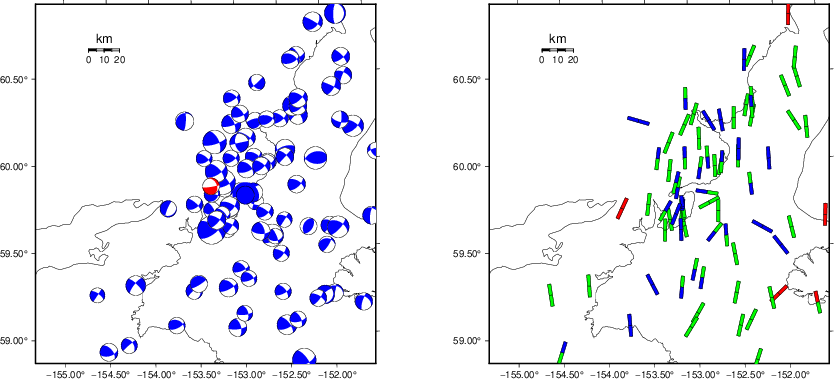Location
Location ANSS
The ANSS event ID is ak0258yp1qg3 and the event page is at
https://earthquake.usgs.gov/earthquakes/eventpage/ak0258yp1qg3/executive.
2025/07/14 12:18:02 59.871 -153.331 134.8 4.4 Alaska
Focal Mechanism
USGS/SLU Moment Tensor Solution
ENS 2025/07/14 12:18:02.0 59.87 -153.33 134.8 4.4 Alaska
Stations used:
AK.BRLK AK.CAST AK.FIRE AK.L19K AK.L22K AK.M16K AK.M20K
AK.N18K AK.O18K AK.O19K AK.P17K AK.PPLA AK.Q19K AK.RC01
AK.SKN AK.SLK AK.SWD AV.ACH AV.RED AV.SPCL II.KDAK
Filtering commands used:
cut o DIST/3.3 -40 o DIST/3.3 +50
rtr
taper w 0.1
hp c 0.03 n 3
lp c 0.10 n 3
Best Fitting Double Couple
Mo = 2.43e+22 dyne-cm
Mw = 4.19
Z = 134 km
Plane Strike Dip Rake
NP1 83 83 -119
NP2 340 30 -15
Principal Axes:
Axis Value Plunge Azimuth
T 2.43e+22 31 197
N 0.00e+00 29 87
P -2.43e+22 45 324
Moment Tensor: (dyne-cm)
Component Value
Mxx 8.17e+21
Mxy 1.07e+22
Mxz -2.01e+22
Myy -2.73e+21
Myz 3.99e+21
Mzz -5.44e+21
---###########
--------------########
--------------------########
-----------------------#######
---------------------------#######
---------- ----------------#######
----------- P -----------------#######
------------ ------------------#######
----------------------------------######
-----------------------------------#######
------------------------------------#-----
----------------------------########------
###--------#########################------
###################################-----
###################################-----
##################################----
################################----
########### ################----
######### T ###############---
######## ##############---
####################--
##############
Global CMT Convention Moment Tensor:
R T P
-5.44e+21 -2.01e+22 -3.99e+21
-2.01e+22 8.17e+21 -1.07e+22
-3.99e+21 -1.07e+22 -2.73e+21
Details of the solution is found at
http://www.eas.slu.edu/eqc/eqc_mt/MECH.NA/20250714121802/index.html
|
Preferred Solution
The preferred solution from an analysis of the surface-wave spectral amplitude radiation pattern, waveform inversion or first motion observations is
STK = 340
DIP = 30
RAKE = -15
MW = 4.19
HS = 134.0
The NDK file is 20250714121802.ndk
The waveform inversion is preferred.
Magnitudes
Given the availability of digital waveforms for determination of the moment tensor, this section documents the added processing leading to mLg, if appropriate to the region, and ML by application of the respective IASPEI formulae. As a research study, the linear distance term of the IASPEI formula
for ML is adjusted to remove a linear distance trend in residuals to give a regionally defined ML. The defined ML uses horizontal component recordings, but the same procedure is applied to the vertical components since there may be some interest in vertical component ground motions. Residual plots versus distance may indicate interesting features of ground motion scaling in some distance ranges. A residual plot of the regionalized magnitude is given as a function of distance and azimuth, since data sets may transcend different wave propagation provinces.
ML Magnitude

Left: ML computed using the IASPEI formula for Horizontal components. Center: ML residuals computed using a modified IASPEI formula that accounts for path specific attenuation; the values used for the trimmed mean are indicated. The ML relation used for each figure is given at the bottom of each plot.
Right: Residuals from new relation as a function of distance and azimuth.

Left: ML computed using the IASPEI formula for Vertical components (research). Center: ML residuals computed using a modified IASPEI formula that accounts for path specific attenuation; the values used for the trimmed mean are indicated. The ML relation used for each figure is given at the bottom of each plot.
Right: Residuals from new relation as a function of distance and azimuth.
Context
The left panel of the next figure presents the focal mechanism for this earthquake (red) in the context of other nearby events (blue) in the SLU Moment Tensor Catalog. The right panel shows the inferred direction of maximum compressive stress and the type of faulting (green is strike-slip, red is normal, blue is thrust; oblique is shown by a combination of colors). Thus context plot is useful for assessing the appropriateness of the moment tensor of this event.
Waveform Inversion using wvfgrd96
The focal mechanism was determined using broadband seismic waveforms. The location of the event (star) and the
stations used for (red) the waveform inversion are shown in the next figure.
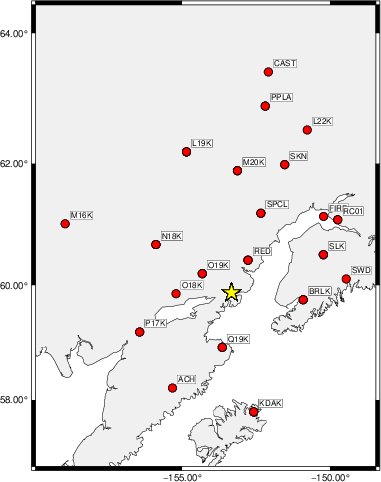
|
|
Location of broadband stations used for waveform inversion
|
The program wvfgrd96 was used with good traces observed at short distance to determine the focal mechanism, depth and seismic moment. This technique requires a high quality signal and well determined velocity model for the Green's functions. To the extent that these are the quality data, this type of mechanism should be preferred over the radiation pattern technique which requires the separate step of defining the pressure and tension quadrants and the correct strike.
The observed and predicted traces are filtered using the following gsac commands:
cut o DIST/3.3 -40 o DIST/3.3 +50
rtr
taper w 0.1
hp c 0.03 n 3
lp c 0.10 n 3
The results of this grid search are as follow:
DEPTH STK DIP RAKE MW FIT
WVFGRD96 2.0 65 70 15 3.22 0.1928
WVFGRD96 4.0 200 50 -10 3.26 0.2040
WVFGRD96 6.0 200 55 -10 3.32 0.2392
WVFGRD96 8.0 200 50 -15 3.42 0.2675
WVFGRD96 10.0 200 55 -10 3.46 0.2832
WVFGRD96 12.0 200 55 -10 3.50 0.2909
WVFGRD96 14.0 200 60 -10 3.53 0.2928
WVFGRD96 16.0 195 55 -10 3.56 0.2906
WVFGRD96 18.0 195 55 -5 3.58 0.2859
WVFGRD96 20.0 195 55 -5 3.60 0.2788
WVFGRD96 22.0 195 55 0 3.62 0.2703
WVFGRD96 24.0 190 55 -10 3.64 0.2626
WVFGRD96 26.0 190 55 -5 3.65 0.2543
WVFGRD96 28.0 -5 70 -30 3.68 0.2465
WVFGRD96 30.0 -5 70 -30 3.69 0.2387
WVFGRD96 32.0 0 70 -15 3.68 0.2343
WVFGRD96 34.0 0 65 -10 3.70 0.2315
WVFGRD96 36.0 0 65 -10 3.71 0.2283
WVFGRD96 38.0 0 65 -10 3.74 0.2258
WVFGRD96 40.0 220 40 60 3.83 0.2283
WVFGRD96 42.0 220 40 65 3.86 0.2281
WVFGRD96 44.0 225 40 70 3.87 0.2254
WVFGRD96 46.0 -5 60 -20 3.88 0.2229
WVFGRD96 48.0 -5 60 -20 3.89 0.2234
WVFGRD96 50.0 -5 60 -20 3.91 0.2247
WVFGRD96 52.0 -5 60 -20 3.92 0.2256
WVFGRD96 54.0 -5 60 -20 3.93 0.2264
WVFGRD96 56.0 -5 60 -20 3.94 0.2284
WVFGRD96 58.0 160 90 -25 3.97 0.2340
WVFGRD96 60.0 340 55 -10 3.98 0.2498
WVFGRD96 62.0 340 55 -10 4.00 0.2724
WVFGRD96 64.0 335 60 -10 4.02 0.2976
WVFGRD96 66.0 330 60 -20 4.04 0.3351
WVFGRD96 68.0 330 60 -20 4.06 0.3787
WVFGRD96 70.0 330 55 -20 4.07 0.4195
WVFGRD96 72.0 330 55 -20 4.08 0.4511
WVFGRD96 74.0 330 55 -20 4.09 0.4669
WVFGRD96 76.0 335 50 -15 4.10 0.4767
WVFGRD96 78.0 335 50 -15 4.11 0.4879
WVFGRD96 80.0 335 50 -15 4.11 0.4973
WVFGRD96 82.0 335 50 -15 4.11 0.5058
WVFGRD96 84.0 335 50 -15 4.12 0.5135
WVFGRD96 86.0 335 50 -15 4.12 0.5184
WVFGRD96 88.0 335 50 -10 4.13 0.5248
WVFGRD96 90.0 335 50 -10 4.13 0.5322
WVFGRD96 92.0 330 30 -25 4.13 0.5386
WVFGRD96 94.0 330 25 -25 4.14 0.5490
WVFGRD96 96.0 330 25 -25 4.14 0.5610
WVFGRD96 98.0 335 25 -20 4.15 0.5723
WVFGRD96 100.0 335 25 -20 4.16 0.5813
WVFGRD96 102.0 335 25 -20 4.16 0.5917
WVFGRD96 104.0 335 25 -20 4.16 0.5998
WVFGRD96 106.0 335 25 -20 4.16 0.6055
WVFGRD96 108.0 335 25 -20 4.17 0.6136
WVFGRD96 110.0 335 25 -20 4.17 0.6173
WVFGRD96 112.0 335 25 -20 4.17 0.6244
WVFGRD96 114.0 335 25 -20 4.17 0.6285
WVFGRD96 116.0 335 25 -20 4.17 0.6337
WVFGRD96 118.0 335 25 -20 4.18 0.6383
WVFGRD96 120.0 335 25 -20 4.18 0.6407
WVFGRD96 122.0 335 25 -20 4.18 0.6447
WVFGRD96 124.0 340 30 -15 4.18 0.6459
WVFGRD96 126.0 340 30 -15 4.19 0.6503
WVFGRD96 128.0 340 30 -15 4.19 0.6500
WVFGRD96 130.0 340 30 -15 4.19 0.6532
WVFGRD96 132.0 340 30 -15 4.19 0.6522
WVFGRD96 134.0 340 30 -15 4.19 0.6550
WVFGRD96 136.0 340 30 -15 4.19 0.6538
WVFGRD96 138.0 340 30 -15 4.19 0.6548
WVFGRD96 140.0 340 30 -15 4.19 0.6527
WVFGRD96 142.0 340 30 -15 4.19 0.6512
WVFGRD96 144.0 340 30 -15 4.19 0.6482
WVFGRD96 146.0 340 30 -15 4.19 0.6464
WVFGRD96 148.0 340 30 -15 4.20 0.6440
The best solution is
WVFGRD96 134.0 340 30 -15 4.19 0.6550
The mechanism corresponding to the best fit is
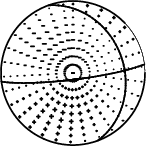
|
|
Figure 1. Waveform inversion focal mechanism
|
The best fit as a function of depth is given in the following figure:
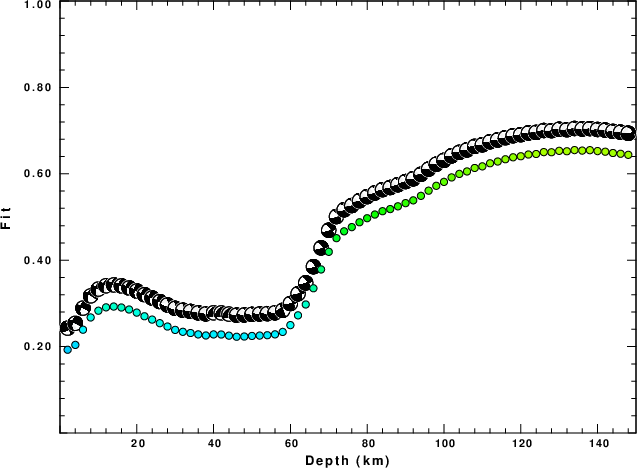
|
|
Figure 2. Depth sensitivity for waveform mechanism
|
The comparison of the observed and predicted waveforms is given in the next figure. The red traces are the observed and the blue are the predicted.
Each observed-predicted component is plotted to the same scale and peak amplitudes are indicated by the numbers to the left of each trace. A pair of numbers is given in black at the right of each predicted traces. The upper number it the time shift required for maximum correlation between the observed and predicted traces. This time shift is required because the synthetics are not computed at exactly the same distance as the observed, the velocity model used in the predictions may not be perfect and the epicentral parameters may be be off.
A positive time shift indicates that the prediction is too fast and should be delayed to match the observed trace (shift to the right in this figure). A negative value indicates that the prediction is too slow. The lower number gives the percentage of variance reduction to characterize the individual goodness of fit (100% indicates a perfect fit).
The bandpass filter used in the processing and for the display was
cut o DIST/3.3 -40 o DIST/3.3 +50
rtr
taper w 0.1
hp c 0.03 n 3
lp c 0.10 n 3
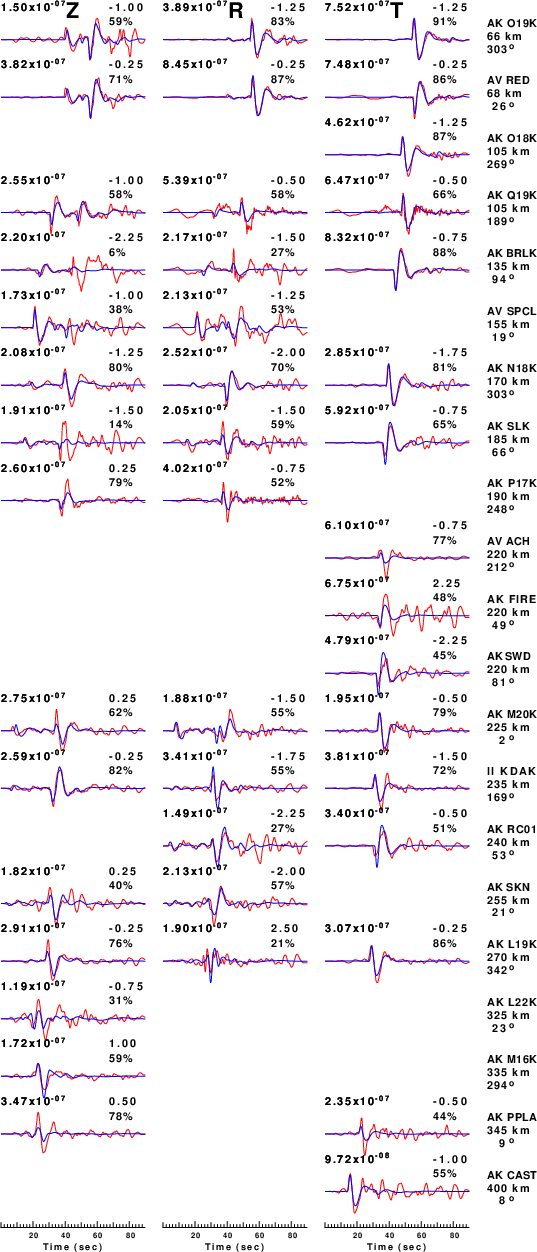
|
|
Figure 3. Waveform comparison for selected depth. Red: observed; Blue - predicted. The time shift with respect to the model prediction is indicated. The percent of fit is also indicated. The time scale is relative to the first trace sample.
|
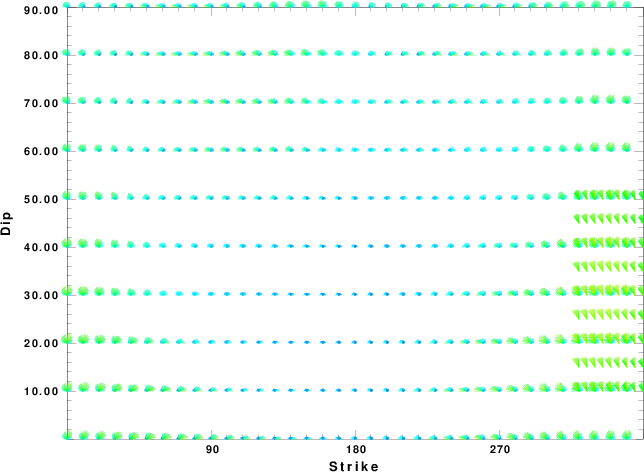
|
|
Focal mechanism sensitivity at the preferred depth. The red color indicates a very good fit to the waveforms.
Each solution is plotted as a vector at a given value of strike and dip with the angle of the vector representing the rake angle, measured, with respect to the upward vertical (N) in the figure.
|
A check on the assumed source location is possible by looking at the time shifts between the observed and predicted traces. The time shifts for waveform matching arise for several reasons:
- The origin time and epicentral distance are incorrect
- The velocity model used for the inversion is incorrect
- The velocity model used to define the P-arrival time is not the
same as the velocity model used for the waveform inversion
(assuming that the initial trace alignment is based on the
P arrival time)
Assuming only a mislocation, the time shifts are fit to a functional form:
Time_shift = A + B cos Azimuth + C Sin Azimuth
The time shifts for this inversion lead to the next figure:
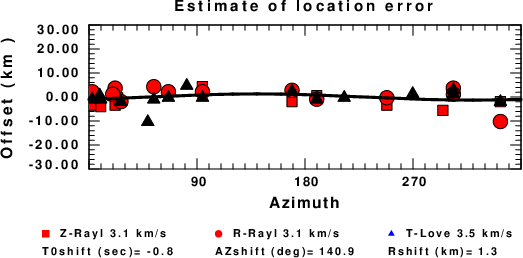
The derived shift in origin time and epicentral coordinates are given at the bottom of the figure.
Velocity Model
The WUS.model used for the waveform synthetic seismograms and for the surface wave eigenfunctions and dispersion is as follows
(The format is in the model96 format of Computer Programs in Seismology).
MODEL.01
Model after 8 iterations
ISOTROPIC
KGS
FLAT EARTH
1-D
CONSTANT VELOCITY
LINE08
LINE09
LINE10
LINE11
H(KM) VP(KM/S) VS(KM/S) RHO(GM/CC) QP QS ETAP ETAS FREFP FREFS
1.9000 3.4065 2.0089 2.2150 0.302E-02 0.679E-02 0.00 0.00 1.00 1.00
6.1000 5.5445 3.2953 2.6089 0.349E-02 0.784E-02 0.00 0.00 1.00 1.00
13.0000 6.2708 3.7396 2.7812 0.212E-02 0.476E-02 0.00 0.00 1.00 1.00
19.0000 6.4075 3.7680 2.8223 0.111E-02 0.249E-02 0.00 0.00 1.00 1.00
0.0000 7.9000 4.6200 3.2760 0.164E-10 0.370E-10 0.00 0.00 1.00 1.00
Last Changed Mon Jul 14 08:12:44 CDT 2025


